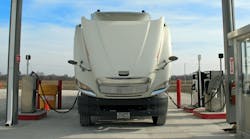Natural gas vehicles do not require a lot of specialty maintenance, but service to vehicles using this type of fuel requires some safety modifications for maintenance facilities. The U.S. Department of Energy's Office of Energy Efficiency & Renewable Energy offers the following guidelines:
Because CNG is lighter than air, it will rise to the ceiling of the maintenance facility in the event of a leak and dissipate, unlike liquid fuel vapors. If concentrations encounter an ignition source, the natural gas can ignite, creating a dangerous situation. In practice, natural gas typically dissipates quickly enough to avoid issue and is less flammable than gasoline, so this is not usually an issue. But to ensure safety, it is still important to install a combustible-gas detector and control system for indoor maintenance facilities. This helps ensure that there is sufficient ventilation and air flow to reduce the concentration of released gas.
In addition, facilities must ensure that space heating is designed according to specific guidelines so that open flames and hot sources will not provide an ignition source for the natural gas. Electrical wiring and equipment must also be installed in a manner that does not provide sources of ignition due to sparking. The equipment itself should be designed to be "explosion proof."
The U.S. DOE's Clean Cities program can assist fleets and facility maintenance managers in locating qualified facility assessors, design engineers and construction firms with CNG experience to ensure that facilities are safe and compliant with local and national codes and regulations. Visit cleancities.energy.gov to find a local Clean Cities coordinator.
Although natural gas maintenance facilities require extra modifications to prevent gas leaks, maintenance on the vehicles themselves is relatively similar to gasoline vehicles. The most important maintenance requirement is that fuel storage tanks should be inspected at regular intervals. It is important to know the end-of-life date on the tank so that it is not used past this date. Tanks should be inspected every three years or 36,000 miles, and after any incident that could cause damage to the tank.
Oil change intervals for natural gas engines tend to be much longer. In conventional vehicles, engine oil degrades due to soot and other impurities. Clean burning fuels such as natural gas produce less of these contaminants, helping oils to last longer. Fleet managers should consult their maintenance manual for the proper oil-change interval. It might be beneficial for managers to send oil samples to a laboratory for testing to better understand the maximum useful life for each oil change.
Another key item to note with maintenance is that natural gas engines use spark plugs to ignite the fuel tanks. Because natural gas is sensitive to spark quality and voltage, it is important that all parts of the ignition system, including spark plugs, wires and coils, be properly maintained and protected from excessive heat and damage. Some manufacturers produce natural gas vehicle-specific spark plug ignition wire and engine oils to help maximize the vehicle's performance and engine life.
Understanding the differences in facility requirements and maintenance requirements for natural gas vehicles will help ensure that technicians are able to safely and effectively work on these vehicles to maximize efficiency and uptime.



